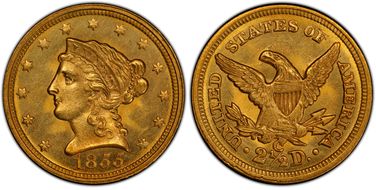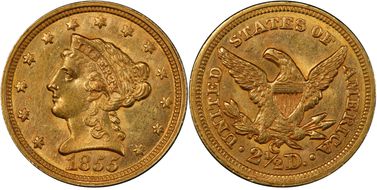- PCGS #:
- 7775
- Designer:
- Christian Gobrecht
- Edge:
- Reeded
- Diameter:
- 18.00 millimeters
- Weight:
- 4.18 grams
- Mintage:
- 3,677
- Mint:
- Charlotte
- Metal:
- 90% Gold, 10% Copper
- Auction Record:
- $97,750 • MS65 • 01-03-2012 • Heritage Auctions
Major Varieties
- 1855-C $2.50
Go To Grade
Current Auctions - PCGS Graded
Current Auctions - NGC Graded
For Sale Now at Collectors Corner - PCGS Graded
For Sale Now at Collectors Corner - NGC Graded
Rarity and Survival Estimates Learn More
| Survival Estimate | |
|---|---|
| All Grades | 90 |
| 60 or Better | 6 |
| 65 or Better | 1 |
| Numismatic Rarity | |
|---|---|
| All Grades | R-8.1 |
| 60 or Better | R-9.7 |
| 65 or Better | R-10.0 |
| Relative Rarity By Type All Specs in this Type | |
|---|---|
| All Grades | 27 / 147 TIE |
| 60 or Better | 27 / 147 TIE |
| 65 or Better | 1 / 147 TIE |
| Relative Rarity By Series All Specs in this Series | |
|---|---|
| All Grades | 27 / 147 TIE |
| 60 or Better | 27 / 147 TIE |
| 65 or Better | 1 / 147 TIE |
Condition Census What Is This?
Doug Winter:
The 1855-C has the lowest mintage of any individual date Charlotte quarter eagle. It has the second lowest reported mintage figure of any quarter eagle from this mint, trailing only the 1843-C Small Date.
The 1855-C remains one of the scarcest Charlotte quarter eagles in terms of overall rarity. It is now more available in higher grades than in the past. This is due to a combination of newly discovered coins and grade-flation, which has allowed some previously regarded as AU55 and AU58 to now be called MS61. The distribution of survivors for this issue skews a bit to the high side and this suggest that there may have been a small hoard of relatively choice pieces at one time.
STRIKE: The 1855-C is one of the two most poorly struck Charlotte quarter eagles produced in the 1850s. The obverse center is quite weak with considerable flatness noted on the curls around the face and below the ear. The stars are almost totally flat with just a few showing radial lines. The sharpest area on the obverse is at the top of Liberty’s head. It is not uncommon to see examples with nearly full hair, despite the weakness seen in the rest of the obverse. The reverse is a bit better struck overall. It is usually weak on the eagle’s right leg, the lowest portion of the shield, the arrow feather and the left claw. The border tends to be much sharper with strong lettering and full denticles.
SURFACES: Almost every 1855-C quarter eagle I have seen is very heavily abraded. This is even the case with most of the higher graded examples of this date. The abrasions are often compounded by noticeable hairlines from prior cleanings. I have seen many examples that have small mint-made chips in the planchet. These tend to be located in the right obverse field or on the reverse above and behind the eagle’s head.
LUSTER: The luster is better than one might expect, given this issue’s poor strike. The texture seen on higher grade examples is soft and frosty. Many have disturbed luster due to having been cleaned or processed at one time.
COLORATION: Original, uncleaned examples have either medium to deep green-gold or rich orange-gold hues. This coloration can be extremely attractive. Unfortunately, in the past few years most examples have been dipped or cleaned and it has become very hard to fine an 1855-C with original hues.
EYE APPEAL: The fact that this issue tends to be found with a poor strike makes it very hard to locate individual coins with good overall eye appeal. Since the publication of the last edition of this book a decade ago, a few exceptional 1855-C quarter eagles that were previously unknown to me have come onto the market and raised the standards of eye appeal for this issue. That said, the typical example is still below average in appearance.
DIE CHARACTERISTICS: All known examples show a small break, which resembles a cud, at 7:00 to 8:00 on the reverse.
DIE VARIETIES: A single variety is known.
Variety 1 (formerly Variety 16-1): The 1 in the date is equidistant from the bust and the denticles. The second 5 is also equidistant from the bust and the denticles. The reverse is the same as described above for the 1852-C quarter eagle.
The 1855-C remains one of the scarcest Charlotte quarter eagles in terms of overall rarity. It is now more available in higher grades than in the past. This is due to a combination of newly discovered coins and grade-flation, which has allowed some previously regarded as AU55 and AU58 to now be called MS61. The distribution of survivors for this issue skews a bit to the high side and this suggest that there may have been a small hoard of relatively choice pieces at one time.
STRIKE: The 1855-C is one of the two most poorly struck Charlotte quarter eagles produced in the 1850s. The obverse center is quite weak with considerable flatness noted on the curls around the face and below the ear. The stars are almost totally flat with just a few showing radial lines. The sharpest area on the obverse is at the top of Liberty’s head. It is not uncommon to see examples with nearly full hair, despite the weakness seen in the rest of the obverse. The reverse is a bit better struck overall. It is usually weak on the eagle’s right leg, the lowest portion of the shield, the arrow feather and the left claw. The border tends to be much sharper with strong lettering and full denticles.
SURFACES: Almost every 1855-C quarter eagle I have seen is very heavily abraded. This is even the case with most of the higher graded examples of this date. The abrasions are often compounded by noticeable hairlines from prior cleanings. I have seen many examples that have small mint-made chips in the planchet. These tend to be located in the right obverse field or on the reverse above and behind the eagle’s head.
LUSTER: The luster is better than one might expect, given this issue’s poor strike. The texture seen on higher grade examples is soft and frosty. Many have disturbed luster due to having been cleaned or processed at one time.
COLORATION: Original, uncleaned examples have either medium to deep green-gold or rich orange-gold hues. This coloration can be extremely attractive. Unfortunately, in the past few years most examples have been dipped or cleaned and it has become very hard to fine an 1855-C with original hues.
EYE APPEAL: The fact that this issue tends to be found with a poor strike makes it very hard to locate individual coins with good overall eye appeal. Since the publication of the last edition of this book a decade ago, a few exceptional 1855-C quarter eagles that were previously unknown to me have come onto the market and raised the standards of eye appeal for this issue. That said, the typical example is still below average in appearance.
DIE CHARACTERISTICS: All known examples show a small break, which resembles a cud, at 7:00 to 8:00 on the reverse.
DIE VARIETIES: A single variety is known.
Variety 1 (formerly Variety 16-1): The 1 in the date is equidistant from the bust and the denticles. The second 5 is also equidistant from the bust and the denticles. The reverse is the same as described above for the 1852-C quarter eagle.
David Akers (1975/88):
Very rare in all grades and to the best of my knowledge, unique in uncirculated condition. (The only known Unc. is in a Connecticut collection.) All known specimens are softly struck, particularly on the head of Liberty, the eagle's legs and on the feathers of the arrows. Every specimen that I have seen also has a partial wire rim and a minor "cud" on the reverse rim below the denomination. In addition to the aforementioned Unc., I have seen at least four or five different AU's and a fair number of EF's.




